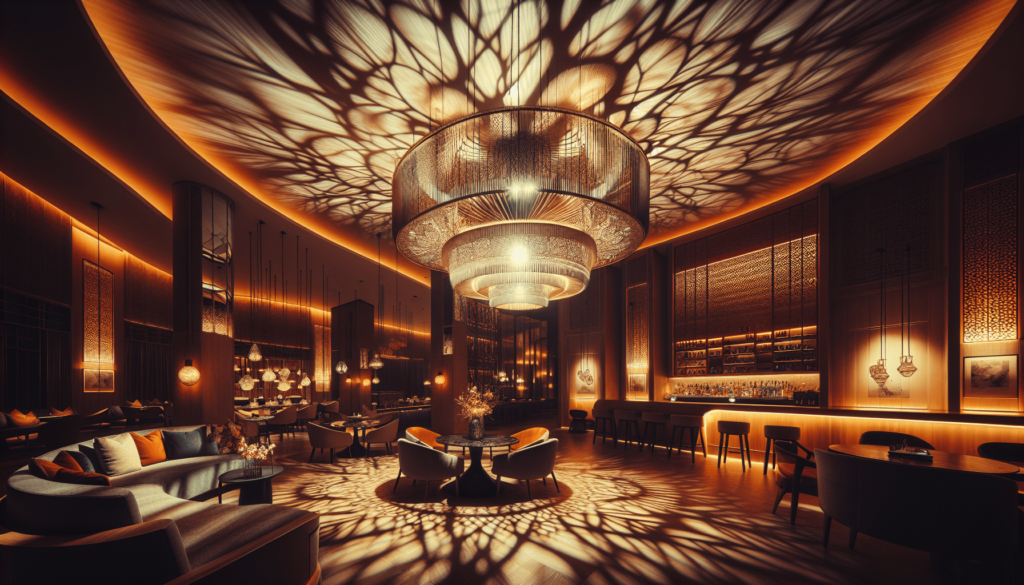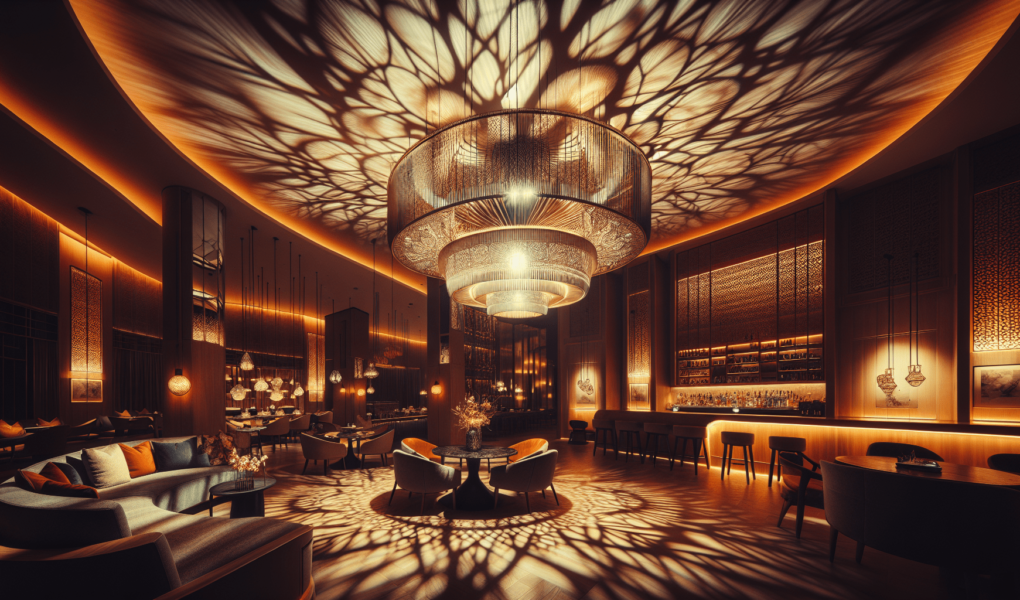Step into a world where lighting not only serves a functional purpose, but also creates an immersive and memorable experience for guests. In the article “Illuminating Hospitality: Innovative Approaches to Lighting Design in the Industry,” we explore the fascinating realm of hospitality lighting design. Discover how this often overlooked aspect of the industry is revolutionizing spaces, elevating ambience, and ultimately enhancing the overall guest experience. With innovative techniques and cutting-edge technologies, hotels, restaurants, and resorts are transforming their spaces into captivating environments that leave a lasting impression on their visitors. So, prepare to be amazed as we shed light on the remarkable ways lighting design is illuminating the hospitality industry.

Importance of Lighting Design in the Hospitality Industry
Lighting design plays a crucial role in the hospitality industry, as it contributes to creating a desired ambiance and enhancing the overall guest experience. With the right lighting, hotels, restaurants, and other hospitality establishments can promote safety, highlight architectural features, and even influence their branding and atmosphere. In this article, we will explore the different aspects of lighting design in the hospitality industry, from traditional approaches to emerging trends and technologies, as well as sustainable practices and future directions.
Creating Ambiance and Mood
One of the primary functions of lighting design in the hospitality industry is to create a specific ambiance and mood. By selecting the right lighting fixtures, intensities, colors, and placement, designers can set the tone for each space. Whether it’s a cozy and intimate atmosphere in a restaurant or a vibrant and energetic ambiance in a bar, lighting design has the power to evoke emotions and enhance the overall aesthetics.
Enhancing Guest Experience
Lighting significantly impacts the guest experience in hospitality establishments. It can make guests feel comfortable, welcomed, and at ease. Properly illuminated spaces help guests navigate through the premises, find their way in dimly lit areas, and highlight key points of interest. By carefully considering lighting design, hotels and restaurants can ensure a positive and memorable experience for their guests.
Highlighting Architectural Features
Another important aspect of lighting design in the hospitality industry is the ability to highlight architectural features. Well-designed lighting can draw attention to unique elements of a building’s design or create a focal point in a space. Whether it’s illuminating an intricate ceiling design, showcasing a beautiful staircase, or emphasizing the textures of a wall, lighting designers can transform the visual appeal of a space by using the right techniques and fixtures.
Promoting Safety and Security
Lighting also plays a vital role in promoting safety and security in hospitality establishments. Adequate lighting helps prevent accidents and ensures that guests can navigate through the premises without any hazards. Strategic placement of lighting fixtures can illuminate pathways, staircases, and entrances, minimizing the risk of slips, trips, and falls. Additionally, well-lit outdoor spaces provide a sense of security and deter potential threats.
Traditional Lighting Approaches in Hospitality
In the past, hospitality lighting primarily relied on traditional lighting approaches such as incandescent, fluorescent, and halogen lighting. While these methods have served their purpose, they have certain limitations in terms of energy efficiency, lifespan, and customization options. However, it is worth noting their characteristics and applications in the industry.
Incandescent Lighting
Incandescent lighting was commonly used in hospitality establishments due to its warm and inviting ambiance. These bulbs produce light by heating a filament until it glows. However, they have a relatively short lifespan and are highly energy-consuming, making them less environmentally friendly than modern alternatives.
Fluorescent Lighting
Fluorescent lighting is known for its energy efficiency and longevity. These fixtures produce light by passing an electric current through mercury vapor, which then emits ultraviolet light that excites phosphors to create visible light. Although they are economical, fluorescent lights can sometimes emit a harsh, cold light, which may not be suitable for all hospitality spaces.
Halogen Lighting
Halogen lighting offers a bright and crisp light that is often used to accentuate specific areas or objects. These bulbs are similar to incandescent bulbs but have a small amount of halogen gas inside, which helps recycle the evaporated tungsten and lengthens the bulb’s life. Although halogen lights offer excellent color rendering, they are not as energy-efficient as other options and generate a significant amount of heat.
Emerging Trends and Technologies
As technology advances, new lighting trends and technologies are transforming the hospitality industry. From LED lighting to wireless controls and smart lighting systems, these innovations offer enhanced energy efficiency, customization, and versatility.
LED Lighting
LED lighting has revolutionized the hospitality industry with its numerous benefits. LED bulbs are highly energy-efficient, consuming significantly less power than traditional lighting options. They also have a longer lifespan, reducing the need for frequent bulb replacements. Furthermore, LED lights offer a wide range of color temperatures and can be dimmable, allowing for precise control over the ambiance and mood of a space.
Wireless Lighting Controls
Wireless lighting controls have simplified the management and customization of lighting systems in hospitality establishments. With the ability to control lighting fixtures remotely, hotel staff can adjust the lighting levels, color temperature, and even create pre-set scenes easily. This flexibility allows for seamless transitions between different atmospheres throughout the day or for special events.
Smart Lighting Systems
Smart lighting systems take lighting control to the next level by integrating with other technologies. These systems can automatically adjust lighting levels based on natural light availability, occupancy sensors, or programmed schedules. They offer increased energy efficiency by optimizing lighting usage and reducing unnecessary energy consumption. With smart lighting systems, hospitality establishments can create personalized experiences tailored to each guest’s preferences.
Case Studies: Innovative Lighting Applications
To understand the potential of innovative lighting design in the hospitality industry, let’s explore a few case studies where lighting has been used creatively to enhance guest experiences and create unique atmospheres.
Dynamic Lighting in Hotel Lobbies
In some hotel lobbies, dynamic lighting systems are used to create a visually captivating experience for guests. These systems integrate color-changing LED lights, allowing the ambiance to transform gradually throughout the day. From vibrant and energetic hues during daytime to soothing and calming tones in the evening, dynamic lighting sets the desired mood and leaves a lasting impression on guests.
Artificial Skylights and Bioluminescent Features
To bring the outdoors inside, some hospitality establishments have started incorporating artificial skylights and bioluminescent features. These innovative lighting solutions mimic natural daylight or starry skies, providing an immersive experience for guests. By simulating the beauty of nature, hotels and restaurants create a sense of tranquility and connection with the environment.
Integrating Lighting with Audio-Visual Technology
Lighting design can be seamlessly integrated with audio-visual technology to create immersive experiences in hospitality spaces. By synchronizing lighting effects with sound and visual displays, establishments can captivate their guests and enhance the overall atmosphere. From live performances to themed events, this integration adds a new dimension to the guest experience.
Interactive Lighting Experiences
In certain hospitality venues, interactive lighting experiences have become a focal point for guests. These installations utilize sensors and technology to respond to guests’ movements or actions, creating dynamic and engaging lighting displays. From interactive dance floors to touch-sensitive walls, these experiences encourage guest interaction and create memorable moments.

Sustainable Lighting Practices in Hospitality
With growing environmental awareness, sustainable lighting practices have become essential in the hospitality industry. By adopting energy-efficient lighting fixtures, integrating natural light, and implementing smart lighting controls, establishments can reduce their carbon footprint and contribute to a greener future.
Energy-Efficient Lighting Fixtures
Energy-efficient lighting fixtures, such as LED bulbs, provide excellent illumination while consuming less energy than traditional options. By retrofitting existing fixtures or installing new energy-efficient lighting systems, establishments can significantly reduce their energy consumption. This not only helps the environment but also leads to substantial cost savings on electricity bills.
Natural Light Integration
Incorporating natural light through architectural design plays a vital role in sustainable lighting practices. By strategically placing windows, skylights, or light tubes, hospitality spaces can maximize the use of natural daylight. This reduces the need for artificial lighting during the day, saving energy and creating a more pleasant environment for guests.
Smart Lighting Controls for Energy Savings
Smart lighting controls enable establishments to optimize energy usage by automatically adjusting lighting levels based on occupancy, time of day, or available natural light. By dimming or turning off lights in unoccupied areas, establishments can reduce unnecessary energy consumption. Additionally, motion sensors and daylight sensors can be integrated into the system to ensure that lighting is utilized only when needed.
The Role of Lighting in Branding and Atmosphere
In the highly competitive hospitality industry, establishing a unique and memorable identity is crucial. Lighting design plays a vital role in shaping the branding and atmosphere of an establishment, allowing it to stand out from the crowd and leave a lasting impression on guests.
Creating a Unique and Memorable Identity
By carefully curating the lighting design, hospitality establishments can create a distinctive and memorable identity. Whether it’s through a specific color palette, lighting fixtures with unique shapes, or innovative lighting installations, establishments can differentiate themselves and create a strong visual identity that resonates with their target audience.
Matching Lighting Design to Brand Image
A brand’s image and values should be reflected in every aspect of its physical presence, including lighting design. Establishments can align their lighting design with their brand image by considering factors such as color symbolism, intensity, and style. For example, a luxury hotel may opt for warm, soft lighting to create an inviting and elegant ambiance, while a trendy boutique hotel might prefer bold and dynamic lighting fixtures to convey a contemporary and energetic atmosphere.
Lighting for Different Hospitality Segments
Different hospitality segments have unique lighting requirements to cater to their specific target markets. For instance, a fine dining restaurant may focus on creating an intimate and elegant atmosphere with dim, warm lighting, while a beachfront resort may emphasize vibrant lighting to evoke a sense of energy and excitement. Understanding the characteristics and preferences of each segment is crucial in tailoring the lighting design accordingly.
Exploring Cross-Industry Collaborations
Innovative lighting design can go beyond the boundaries of the hospitality industry by exploring cross-industry collaborations. By partnering with lighting designers, architects, and technology experts from other sectors, hospitality establishments can benefit from fresh perspectives and innovative ideas. Collaborations with the entertainment industry, for example, can lead to cutting-edge lighting designs that create unforgettable guest experiences.

Challenges in Implementing Innovative Lighting Design
While innovative lighting design offers numerous benefits to the hospitality industry, there are several challenges that establishments may encounter during the implementation process.
Cost and Return on Investment
Implementing innovative lighting design can require a significant upfront investment. High-quality fixtures, advanced control systems, and integration with other technologies may come with a substantial price tag. However, it is imperative to consider the long-term return on investment, including energy savings, reduced maintenance costs, and the positive impact on guest experience and brand perception.
Technical Considerations and Compatibility
Innovative lighting design often involves complex technical considerations and compatibility issues. Installing new lighting systems may require adjustments to electrical infrastructure and potential disruptions to ongoing operations. Integration with existing technologies in hospitality establishments, such as audio-visual equipment or building management systems, may also present compatibility challenges that need to be carefully addressed during the design and implementation phases.
Maintenance and Long-Term Sustainability
Maintaining innovative lighting systems can be a challenge, especially when dealing with cutting-edge technologies. Regular maintenance and updates are necessary to ensure optimal performance and prevent disruptions. Establishments need to have a plan in place for regular inspections, bulb replacements, system upgrades, and addressing any technical issues that may arise. Additionally, considering the long-term sustainability of lighting systems throughout their lifecycle is key to minimizing environmental impact.
Collaboration between Lighting Designers and Architects
Collaboration between lighting designers and architects is essential for creating cohesive and impactful lighting design in hospitality spaces. By integrating lighting concepts from the early stages of architectural planning, establishments can achieve harmonious and optimized lighting effects.
Early Integration of Lighting Concepts
To achieve the best lighting design possible, it is crucial to involve lighting designers from the early stages of architectural planning. By collaborating closely with architects, lighting designers can offer valuable insights into how lighting can enhance the architectural features and highlight key design elements. This integration ensures that lighting is seamlessly incorporated into the overall design concept of the space.
Optimizing Architectural Features with Lighting
Through collaboration, lighting designers and architects can work together to optimize the visual impact of architectural features. By strategically placing lighting fixtures, adjusting intensities, and using different lighting techniques, establishments can accentuate the architectural elements that make their space unique. This synergy between lighting and architecture creates a cohesive and visually appealing environment.
Material Selection in Conjunction with Lighting Design
The choice of materials used in hospitality spaces plays a vital role in the effectiveness of lighting design. Certain materials can enhance or diminish the lighting effects, depending on their reflective properties. By considering the interaction between materials and lighting, designers can select finishes, textures, and colors that amplify the desired ambiance and create a cohesive visual experience for guests.

Designing Lighting for Different Hospitality Spaces
Different hospitality spaces have unique lighting requirements to serve their specific purposes and enhance the guest experience. Let’s explore some key considerations for lighting design in common spaces.
Hotel Rooms and Suites
Lighting plays a crucial role in hotel rooms and suites, as it directly impacts the comfort and functionality of the space. Guestrooms require a combination of general lighting, task lighting, and ambient lighting to cater to different activities such as reading, working, or relaxation. Dimmable bedside lamps, adjustable overhead lights, and well-placed mirrors are just a few examples of lighting fixtures that enhance the guest experience in hotel rooms.
Restaurants and Bars
Restaurants and bars rely on lighting design to create an inviting and appealing atmosphere for dining and socializing. Lighting designers should consider factors such as table lighting, accent lighting for artwork or architectural features, and overall illumination levels. Different areas within a restaurant, such as the bar versus the dining area, may require specific lighting design treatments to differentiate the spaces and evoke the desired ambiance.
Spas and Wellness Facilities
Lighting plays a crucial role in creating a relaxing and rejuvenating atmosphere in spas and wellness facilities. Soft, warm lighting combined with indirect lighting techniques can create a sense of calm and tranquility. Areas dedicated to massages or facials may benefit from adjustable lighting options to cater to individual preferences and create personalized experiences for guests.
Outdoor Areas and Landscapes
Outdoor lighting design is equally important, as it sets the tone for an establishment’s exteriors. Well-designed lighting in outdoor areas creates a welcoming environment, ensures safety and security, and enhances the architectural features. From landscape lighting to pathway illumination and accent lighting for outdoor seating areas, the right combination of fixtures and techniques transforms outdoor spaces into inviting and visually striking areas.
Future Directions in Hospitality Lighting Design
As technology continues to advance, the future of lighting design in the hospitality industry holds exciting prospects. Here are some potential future directions that establishments can explore.
Biophilic Lighting Design
Biophilic lighting design aims to integrate natural elements and lighting to create a connection to nature within hospitality spaces. This approach can involve using artificial lighting that mimics daylight patterns or incorporating live plants with integrated lighting features. Biophilic lighting design has been shown to enhance well-being, reduce stress, and create a more pleasant environment for guests.
Personalized and Adaptive Lighting
The future of hospitality lighting design may focus on personalized and adaptive lighting solutions. With advancements in sensor technology and artificial intelligence, lighting systems can learn and respond to individual preferences. Customizable lighting scenes, automatic light adjustments based on guest preferences, and adaptive lighting controls that consider factors such as time of day and occupancy are potential avenues for enhancing guest experiences.
Artificial Intelligence and Machine Learning Integration
Artificial intelligence (AI) and machine learning (ML) integration offer exciting possibilities for lighting design in the hospitality industry. AI-powered systems can analyze data from various sources, such as occupancy sensors, weather forecasts, or guest preferences, to optimize lighting settings automatically. ML algorithms can continuously learn and adapt lighting patterns to achieve optimal energy efficiency, guest comfort, and ambiance.
In conclusion, lighting design plays a pivotal role in the hospitality industry, impacting ambiance, guest experience, safety, and branding. From traditional approaches to emerging technologies, the industry continues to innovate and explore new possibilities. By incorporating sustainable practices, collaborating with architects, and considering the unique requirements of different spaces, establishments can create unforgettable experiences for their guests. The future of hospitality lighting design holds immense potential, with advancements in AI, personalized lighting, and a focus on biophilic design. Through the power of lighting, the hospitality industry can continue to illuminate the way forward.



